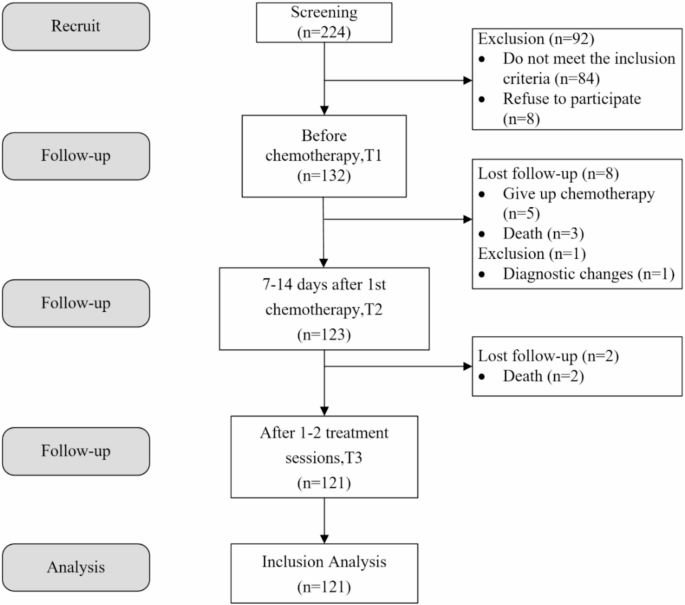Changes in physical fitness in acute leukemia patients during chemotherapy – Scientific Reports

Schölvinck, A. M., de Graaff, B. M. B., van den Beld, M. J. & Broerse, J. E. W. Research in haematological cancers: what do patients in the Netherlands prioritise? Eur. J. Cancer Care. 28, e12989. https://doi.org/10.1111/ecc.12989 (2019).
Rose-Inman, H., Kuehl, D., Acute & Leukemia Hematol. Oncol. Clin. N. Am. 31, 1011–1028, doi:https://doi.org/10.1016/j.hoc.2017.08.006 (2017).
Leak Bryant, A. et al. Perceived benefits and barriers to Exercise for recently treated adults with Acute Leukemia. Oncol. Nurs. Forum. 44, 413–420. https://doi.org/10.1188/17.Onf.413-420 (2017).
Caspersen, C. J., Powell, K. E. & Christenson, G. M. Physical activity, exercise, and physical fitness: definitions and distinctions for health-related research. Public. Health Rep. 100, 126–131 (1985).
Ferguson, B. ACSM’s Guidelines for Exercise Testing and Prescription 9th EdVol. 58 (Canadian Chiropractic Association, 2014).
Crapo, R. et al. ATS statement: guidelines for the six-Minute Walk Test. Am. J. Resp. Crit. Care. 166, 111–117. https://doi.org/10.1164/ajrccm.166.1.at1102 (2002).
Roberts, H. C. et al. A review of the measurement of grip strength in clinical and epidemiological studies: towards a standardised approach. Age Ageing. 40, 423–429. https://doi.org/10.1093/ageing/afr051 (2011).
Ross, R. et al. Importance of assessing Cardiorespiratory Fitness in Clinical Practice: a case for fitness as a Clinical Vital sign: A Scientific Statement from the American Heart Association. Circulation 134, e653–e699. https://doi.org/10.1161/CIR.0000000000000461 (2016).
Kirkham, A. A. et al. Health-related physical fitness assessment in a community-based cancer rehabilitation setting. Supportive care cancer: Official J. Multinational Association Supportive Care Cancer. 23, 2525–2533. https://doi.org/10.1007/s00520-014-2599-z (2015).
Vermaete, N., Wolter, P., Verhoef, G. & Gosselink, R. Physical activity and physical fitness in lymphoma patients before, during, and after chemotherapy: a prospective longitudinal study. Ann. Hematol. 93, 411–424. https://doi.org/10.1007/s00277-013-1881-3 (2014).
Engel, G. L. The need for a new medical model: a challenge for biomedicine. Sci. (New York N Y). 196, 129–136. https://doi.org/10.1126/science.847460 (1977).
Rothman, M. L., Beltran, P., Cappelleri, J. C., Lipscomb, J. & Teschendorf, B. Patient-reported outcomes: conceptual issues. Value Health: J. Int. Soc. Pharmacoeconomics Outcomes Res. 10 (Suppl 2), 66–75. https://doi.org/10.1111/j.1524-4733.2007.00269.x (2007).
U.S. Department of Health and Human Services FDA Center for Drug Evaluation and Research, U. S. D. o. H. a. H. S. F. C. f. B. E. a. R. Guidance for industry: patient-reported outcome measures: use in medical product development to support labeling claims: draft guidance. Health Qual. Life Outcomes. 4 https://doi.org/10.1186/1477-7525-4-79 (2006).
Wiklund, I. Assessment of patient-reported outcomes in clinical trials: the example of health-related quality of life. Fundam. Clin. Pharmacol. 18, 351–363. https://doi.org/10.1111/j.1472-8206.2004.00234.x (2004).
Doward, L. C., Gnanasakthy, A. & Baker, M. G. Patient reported outcomes: looking beyond the label claim. Health Qual. Life Outcomes. 8 https://doi.org/10.1186/1477-7525-8-89 (2010).
Paterson, C., Thomas, K., Manasse, A., Cooke, H. & Peace, G. Measure yourself concerns and wellbeing (MYCaW): an individualised questionnaire for evaluating outcome in cancer support care that includes complementary therapies. Complement. Ther. Med. 15, 38–45. https://doi.org/10.1016/j.ctim.2006.03.006 (2007).
Greenhalgh, J., Long, A. F. & Flynn, R. The use of patient reported outcome measures in routine clinical practice: lack of impact or lack of theory? Social science & medicine (1982) 60, 833–843 https://doi.org/10.1016/j.socscimed.2004.06.022 (2005).
Strand, V. et al. Endpoints: consensus recommendations from OMERACT IV. Outcome measures in Rheumatology. Lupus 9, 322–327. https://doi.org/10.1191/096120300678828424 (2000).
Lenz, E. R., Suppe, F., Gift, A. G., Pugh, L. C. & Milligan, R. A. Collaborative development of middle-range nursing theories: toward a theory of unpleasant symptoms. ANS Adv. Nurs. Sci. 17, 1–13. https://doi.org/10.1097/00012272-199503000-00003 (1995).
Lenz, E. R., Pugh, L. C., Milligan, R. A., Gift, A. & Suppe, F. The middle-range theory of unpleasant symptoms: an update. ANS Adv. Nurs. Sci. 19, 14–27. https://doi.org/10.1097/00012272-199703000-00003 (1997).
Brunner, A. M. et al. Association between baseline body mass index and overall survival among patients over age 60 with acute myeloid leukemia. Am. J. Hematol. 88, 642–646. https://doi.org/10.1002/ajh.23462 (2013).
Kempf, E. et al. Prognosis of body mass index and chemotherapy dose capping in acute myeloid leukaemia. Leuk. Res. 38, 1425–1429. https://doi.org/10.1016/j.leukres.2014.09.013 (2014).
Muller, K. E. & Barton, C. N. Approximate power for repeated-measures ANOVA lacking sphericity. J. Am. Stat. Assoc. 84, 549–555. https://doi.org/10.1080/01621459.1989.10478802 (1989).
Naik, D. N. & Rao, S. S. Analysis of multivariate repeated measures data with a Kronecker product structured covariance matrix. J. Appl. Stat. 28, 91–105. https://doi.org/10.1080/02664760120011626 (2001).
Lin, M., Jiang, X. & Hu, R. Development and validation of the patient-reported outcomes instrument for acute leukemia. Chin. J. Nurs. 54, 350–355. https://doi.org/10.3761/j.issn.0254-1769.2019.03.005 (2019).
Bower, J. E. Cancer-related fatigue–mechanisms, risk factors, and treatments. Nat. Rev. Clin. Oncol. 11, 597–609. https://doi.org/10.1038/nrclinonc.2014.127 (2014).
Menshadi, N., Bar-Tal, Y. & Barnoy, S. The relationship between learned resourcefulness and cancer-related fatigue in patients with non-hodgkin lymphoma. Oncol. Nurs. Forum. 40, 133–138. https://doi.org/10.1188/13.ONF.133-138 (2013).
Bryant, A. L. et al. The effects of Exercise on patient-reported outcomes and performance-based physical function in adults with Acute Leukemia undergoing induction therapy: Exercise and Quality of Life in Acute Leukemia (EQUAL). Integr. cancer Ther. 17, 263–270. https://doi.org/10.1177/1534735417699881 (2018).
Zhang, J. et al. Factors that influence the efficacy of acarbose and metformin as initial therapy in Chinese patients with newly diagnosed type 2 diabetes: a subanalysis of the MARCH trial. Curr. Med. Res. Opin. 32, 713–719. https://doi.org/10.1185/03007995.2015.1136819 (2016).
Xie, M. et al. Barriers to seeking psychosocial support among adult patients with hematologic neoplasms: a qualitative study. Supportive care cancer: Official J. Multinational Association Supportive Care Cancer. 30, 2613–2620. https://doi.org/10.1007/s00520-021-06699-4 (2022).
Virchis, A. et al. Fludarabine, cytosine arabinoside, granulocyte-colony stimulating factor with or without idarubicin in the treatment of high risk acute leukaemia or myelodysplastic syndromes. Br. J. Haematol. 124, 26–32. https://doi.org/10.1046/j.1365-2141.2003.04728.x (2004).
Galinsky, I., Coleman, M., Fechter, L. & Midostaurin Nursing perspectives on managing treatment and adverse events in patients with FLT3 mutation-positive Acute Myeloid Leukemia and Advanced systemic mastocytosis. Clin. J. Oncol. Nurs. 23, 599–608. https://doi.org/10.1188/19.Cjon.599-608 (2019).
Loteta, B. et al. Netupitant/palonosetron without dexamethasone for preventing nausea and vomiting in patients with multiple myeloma receiving high-dose melphalan for autologous stem cell transplantation: a single-center experience. Supportive care cancer: Official J. Multinational Association Supportive Care Cancer. 30, 585–591. https://doi.org/10.1007/s00520-021-06472-7 (2022).
Kowaluk, A. & Wozniewski, M. Peak Oxygen Uptake and Exercise Capacity of children undergoing leukemia treatment. Int. J. Env Res. Pub He. 17, 8732. https://doi.org/10.3390/ijerph17238732 (2020).
Alibhai, S. M. et al. A phase II exercise randomized controlled trial for patients with acute myeloid leukemia undergoing induction chemotherapy. Leuk. Res. 39, 1178–1186. https://doi.org/10.1016/j.leukres.2015.08.012 (2015).
Wehrle, A., Kneis, S., Dickhuth, H. H., Gollhofer, A. & Bertz, H. Endurance and resistance training in patients with acute leukemia undergoing induction chemotherapy-a randomized pilot study. Supportive care cancer: Official J. Multinational Association Supportive Care Cancer. 27, 1071–1079. https://doi.org/10.1007/s00520-018-4396-6 (2019).
Li, Y. et al. The role of mitochondrial Quality Control in Anthracycline-Induced Cardiotoxicity: from bench to Bedside. Oxidative Med. Cell. Longev. 3659278 https://doi.org/10.1155/2022/3659278 (2022).
Bhagat, A., Kleinerman, E. S. & Anthracycline-Induced Cardiotoxicity Causes, mechanisms, and Prevention. Adv. Exp. Med. Biol. 1257, 181–192. https://doi.org/10.1007/978-3-030-43032-0_15 (2020).
Sakai, H. et al. Upregulation of ubiquitinated proteins and their degradation pathway in muscle atrophy induced by cisplatin in mice. Toxicol. Appl. Pharmcol. 403, 115165. https://doi.org/10.1016/j.taap.2020.115165 (2020).
Lin, K. Y. et al. Effects of Exercise in patients undergoing chemotherapy for Head and Neck Cancer: a pilot randomized controlled trial. Int. J. Env Res. Pub He. 18, 1291. https://doi.org/10.3390/ijerph18031291 (2021).
Varedi, M., McKenna, R. & Lamberg, E. M. Balance in children with acute lymphoblastic leukemia. Pediatr. Int. 59, 293–302. https://doi.org/10.1111/ped.13141 (2017).
Ness, K. K., Armenian, S. H., Kadan-Lottick, N. & Gurney, J. G. Adverse effects of treatment in childhood acute lymphoblastic leukemia: general overview and implications for long-term cardiac health. Expert Rev. Hematol. 4, 185–197. https://doi.org/10.1586/ehm.11.8 (2011).
Mohamedali, H. et al. Older age is associated with similar quality of life and physical function compared to younger age during intensive chemotherapy for acute myeloid leukemia. Leuk. Res. 36, 1241–1248. https://doi.org/10.1016/j.leukres.2012.05.020 (2012).
Timilshina, N. et al. Long-term recovery of quality of life and physical function over three years in adult survivors of acute myeloid leukemia after intensive chemotherapy. Leukemia 33, 15–25. https://doi.org/10.1038/s41375-018-0162-5 (2019).
Fukushima, T. et al. Factors associated with muscle function in patients with hematologic malignancies undergoing chemotherapy. Supportive care cancer: Official J. Multinational Association Supportive Care Cancer. 28, 1433–1439. https://doi.org/10.1007/s00520-019-04955-2 (2020).
Chaber, R. et al. Body Mass Index (BMI) and Infectious/Febrile episodes in Children with Intermediate Risk Acute lymphoblastic leukemia (IR ALL). Nutr. Cancer. 71, 701–707. https://doi.org/10.1080/01635581.2018.1516792 (2019).
Meenan, C. K., Kelly, J. A., Wang, L., Ritchey, A. K. & Maurer, S. H. Obesity in pediatric patients with acute lymphoblastic leukemia increases the risk of adverse events during pre-maintenance chemotherapy. Pediatr. Blood Cancer. 66, e27515. https://doi.org/10.1002/pbc.27515 (2019).
Gendron, É. et al. The effect of cardiorespiratory fitness and physical activity levels on cognitive functions in survivors of childhood acute lymphoblastic leukemia. Pediatr. Hematol. Oncol. 37, 582–598. https://doi.org/10.1080/08880018.2020.1767737 (2020).
Lemay, V. et al. Prevention of Long-term adverse health outcomes with Cardiorespiratory Fitness and Physical Activity in Childhood Acute Lymphoblastic Leukemia survivors. J. Pediatr. Hematol. Oncol. 41 (e450-e458). https://doi.org/10.1097/mph.0000000000001426 (2019).
Orgel, E., Nabais, T., Douglas, C., Mittelman, S. D. & Neely, M. Effect of Body Fat on Population Pharmacokinetics of High-Dose Methotrexate in Pediatric patients with Acute Lymphoblastic Leukemia. J. Clin. Pharmacol. 61, 755–762. https://doi.org/10.1002/jcph.1799 (2021).
Cederholm, T., Eriksson, K. & Palmblad, J. Nutrition and acute leukemia in adults: relation to remission rate and survival. Haematologia 32, 405–417 (2002).
Xu, W. et al. Effects of exercise interventions for physical fitness, fatigue, and quality of life in adult hematologic malignancy patients without receiving hematopoietic stem cell transplantation: a systematic review and meta-analysis. Supportive care cancer: Official J. Multinational Association Supportive Care Cancer. 30, 7099–7118. https://doi.org/10.1007/s00520-022-07029-y (2022).
Zhou, Y., Zhu, J., Gu, Z. & Yin, X. Efficacy of Exercise interventions in patients with Acute Leukemia: a Meta-analysis. PloS One. 11, e0159966. https://doi.org/10.1371/journal.pone.0159966 (2016).
Kouzi, S. A. & Uddin, M. N. Aerobic Exercise Training as a potential cardioprotective strategy to Attenuate Doxorubicin-Induced Cardiotoxicity. J. Pharm. Pharm. Sciences: Publication Can. Soc. Pharm. Sci. Societe canadienne des. Sci. Pharmaceutiques. 19, 399–410. https://doi.org/10.18433/j3js5r (2016).
Lemanne, D., Cassileth, B. & Gubili, J. The role of physical activity in cancer prevention, treatment, recovery, and survivorship. Oncol. (Williston Park N Y). 27, 580–585 (2013).
Schmitz, K. H. et al. American College of Sports Medicine roundtable on exercise guidelines for cancer survivors. Med. Sci. Sports. Exerc. 42, 1409–1426. https://doi.org/10.1249/MSS.0b013e3181e0c112 (2010).
Kampshoff, C. S. et al. Randomized controlled trial of the effects of high intensity and low-to-moderate intensity exercise on physical fitness and fatigue in cancer survivors: results of the resistance and endurance exercise after ChemoTherapy (REACT) study. BMC Med. 13, 275. https://doi.org/10.1186/s12916-015-0513-2 (2015).
Related
Yaslen Clemente Shows Off Leg Day Gains and Shares Her…
Yaslen Clemente isn't just an influencer—she's a fitness powerhouse. The social media star is known for her intense workouts, and she recently sha
Samantha Espineira Stuns in Blue Swimsuit and Shares Her 5…
Samantha Espineira knows how to turn heads, both on and off the runway. The successful model and Instagram influencer regularly shares breathtaking
The Best Fitness Trackers To Help You Reach Any Health…
Best Health Tracker: Oura Ring 3Why We Love It: I’ve tried many, many fitness trackers—but I tend not to stick with one watch or band for very long. I’ve
#CycleSyncing debunked: Popular TikTok trend not backed by science
A new study has debunked a popular TikTok wellness trend called cycle syncing, which claims that tailoring a workout routine to match the hormonal changes that












